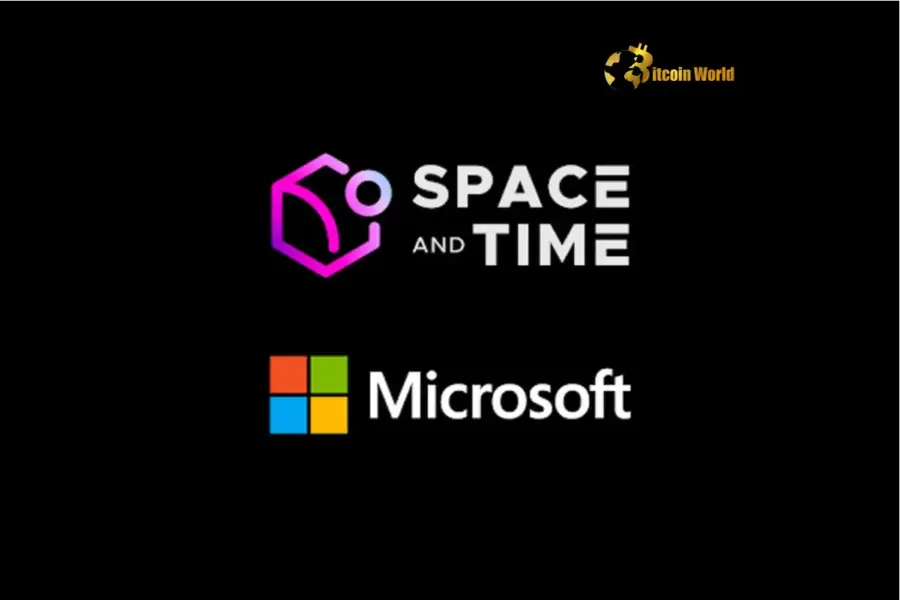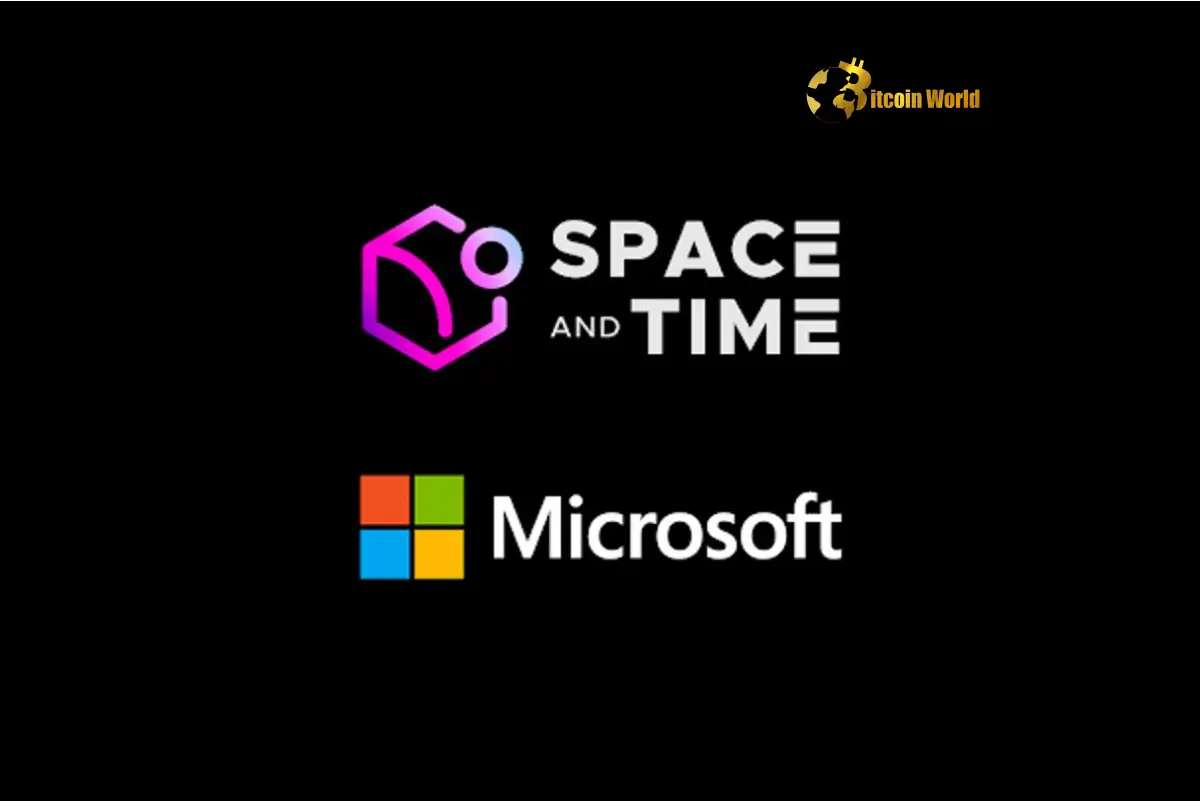Microsoft Fabric Web3 Integration Unlocks Real-Time Blockchain Data Access
0
0

BitcoinWorld

Microsoft Fabric Web3 Integration Unlocks Real-Time Blockchain Data Access
The convergence of traditional enterprise technology and the burgeoning world of Web3 continues to accelerate. A significant stride in this direction has just been announced, bringing powerful new capabilities to data professionals. Microsoft Fabric Web3 integration is now a reality, promising to bridge the gap between centralized data systems and decentralized blockchain networks.
Microsoft’s AI-powered data platform, Fabric, has officially integrated Space & Time (SXT), a decentralized data warehouse. This collaboration marks SXT as the very first Web3 data provider available directly within the Fabric ecosystem. For developers and data analysts, this opens up unprecedented opportunities to access and utilize real-time blockchain data from major networks like Bitcoin, Ethereum, and many others, right alongside their traditional enterprise data.
What Does the Space and Time Crypto Integration Mean for You?
The integration of Space and Time crypto data capabilities into Microsoft Fabric is more than just adding another data source. It represents a fundamental shift in how enterprise users can interact with the decentralized web. Historically, accessing and analyzing blockchain data has been a complex, often cumbersome process requiring specialized tools and expertise. This partnership aims to democratize that access.
Space and Time operates as a decentralized data warehouse and is known for its ability to perform complex queries across both on-chain and off-chain data. Its integration into Fabric means that the rich, transparent, and immutable data stored on various blockchains can now be seamlessly queried, transformed, and analyzed using the familiar and powerful tools within the Microsoft Fabric suite.
Think about the possibilities: combining customer data from a CRM system (in Fabric) with their activity on a blockchain-based loyalty program (via SXT). Or analyzing supply chain data recorded on a private blockchain alongside traditional logistics data, all within a single platform.
Unlocking Seamless Web3 Data Access
The primary benefit of this integration is the ease of Web3 data access it provides. Instead of needing to run blockchain nodes, use specific APIs, or wrestle with complex data structures unique to different blockchains, users can now leverage the connectors within Microsoft Fabric to pull data directly from Space & Time’s indexed blockchain information. This drastically lowers the barrier to entry for businesses and developers looking to build Web3-aware applications or perform analytics on decentralized data.
Here are some key aspects of this enhanced data access:
- Unified Platform: Access Web2 and Web3 data within a single, integrated environment (Microsoft Fabric).
- Simplified Connectivity: Utilize Fabric’s data connectors to interface with Space & Time, abstracting away much of the underlying blockchain complexity.
- Real-Time Data: Gain access to up-to-the-minute data from supported blockchain networks.
- Broad Coverage: Access data from multiple major blockchains, including Bitcoin and Ethereum, with more likely to follow.
- Familiar Tools: Use tools like Power BI, Synapse Data Engineering, and Data Factory within Fabric to work with the Web3 data once it’s connected.
This streamlined approach makes exploring and utilizing decentralized data sources feasible for a much wider audience, moving Web3 data beyond the realm of crypto-native developers and into the hands of enterprise data professionals.
Powering Your Blockchain Data Analytics
With Web3 data readily available in Microsoft Fabric, the opportunities for blockchain data analytics explode. Fabric is built from the ground up as an end-to-end analytics platform, encompassing data ingestion, preparation, warehousing, and business intelligence. Bringing blockchain data into this environment means you can apply sophisticated analytical techniques to previously siloed decentralized information.
Consider these potential analytical use cases:
| Use Case | Description | Relevant Data |
|---|---|---|
| Decentralized Finance (DeFi) Analysis | Track liquidity pool performance, analyze trading volumes on decentralized exchanges (DEXs), monitor lending protocol activity. | Token transfers, smart contract interactions, transaction volumes, gas fees. |
| NFT Market Tracking | Analyze sales trends, floor prices, unique buyer/seller counts, royalty distributions for specific NFT collections. | NFT minting events, transfer records, marketplace sale logs. |
| Supply Chain Transparency | Verify product movements, ownership transfers, and authenticity records stored on a blockchain. | Supply chain transaction records, digital asset movements representing goods. |
| Gaming & Metaverse Analytics | Analyze in-game asset trading, player activity on blockchain games, virtual land sales. | In-game token transactions, NFT asset transfers, smart contract calls related to game logic. |
| Compliance & Auditing | Trace the flow of funds, verify transaction history for auditing purposes, monitor addresses for suspicious activity (where applicable and permissible). | Transaction records, address balances over time, smart contract execution logs. |
By combining blockchain data with other enterprise datasets in Fabric’s unified OneLake storage layer, businesses can gain deeper insights, build more comprehensive reports, and even train machine learning models on a richer dataset that includes decentralized activities.
Powered by Azure OneLake Integration
The technical foundation for this seamless experience lies in the Azure OneLake integration. Microsoft Fabric is built upon Azure OneLake, which acts as a single, logical data lake for an organization. Data from various sources, including now Web3 data via Space & Time, lands in OneLake in a standardized format (Delta Lake), making it immediately available for all of Fabric’s workloads (Data Engineering, Data Science, Data Warehousing, Business Intelligence, Real-Time Analytics).
Space & Time connects to Fabric, enabling users to query SXT’s data directly or ingest it into OneLake. This approach simplifies data governance, reduces data duplication, and ensures that all teams within an organization are working from a consistent source of truth, regardless of whether the data originated from a traditional database, a SaaS application, or a blockchain.
This integration pattern leverages Microsoft’s robust cloud infrastructure (Azure) and its vision for a unified data platform (Fabric) to bring the decentralized world closer to enterprise capabilities. It highlights the increasing maturity of the Web3 data layer and its potential to integrate with existing business intelligence and analytics workflows.
Potential Challenges and Considerations
While this integration is a significant step forward, it’s important to consider potential challenges:
- Data Volume and Complexity: Blockchain data can be massive and complex. While SXT and Fabric simplify access, understanding the nuances of specific blockchain data structures (e.g., decoding smart contract events) still requires some domain knowledge.
- Cost: Accessing and processing large volumes of data, whether in Fabric or through SXT, will incur costs. Users need to manage their data consumption and query patterns efficiently.
- Real-Time Latency: While advertised as real-time, practical latency can depend on the specific blockchain network, SXT’s indexing speed, and the Fabric connector’s performance.
- Evolving Web3 Landscape: The Web3 space is constantly changing. Keeping up with new protocols, data structures, and best practices will be an ongoing process.
Despite these points, the integration provides a powerful starting point and a robust framework for tackling these challenges.
Actionable Insights for Developers and Businesses
If you are a developer or part of a business currently using or considering Microsoft Fabric, here’s what you should do:
- Explore the Connector: Investigate the Space & Time connector within Microsoft Fabric to understand how to configure and use it.
- Identify Use Cases: Brainstorm potential applications within your organization where integrating blockchain data could provide new insights or enable new functionalities.
- Start Small: Begin with a specific project or dataset to get familiar with accessing and working with Web3 data in Fabric.
- Leverage Existing Skills: Utilize your team’s existing expertise in SQL, Python, Power BI, and other Fabric tools to analyze the new data source.
- Stay Informed: Keep up with developments from both Microsoft Fabric and Space & Time regarding new features, supported networks, and best practices.
For Web3 projects and developers, this integration offers a direct path to making their data accessible and useful to a vast enterprise audience, potentially driving adoption and utility.
Conclusion: Bridging Worlds for a Data-Rich Future
The integration of Microsoft Fabric with Space & Time is a landmark event, symbolizing the increasing maturity and convergence of traditional enterprise technology and the decentralized Web3 ecosystem. By providing seamless Web3 data access and powerful blockchain data analytics capabilities within the familiar and robust environment of Microsoft Fabric, powered by Azure OneLake integration, this partnership unlocks new possibilities for developers and businesses alike. It removes significant hurdles, making real-time blockchain data from networks like Bitcoin and Ethereum readily available for analysis, reporting, and application development. As the first Space and Time crypto integration of its kind within Fabric, it sets a precedent for how enterprise platforms can embrace and leverage the potential of decentralized data, paving the way for a more integrated and data-rich future.
To learn more about the latest Web3 data trends, explore our article on key developments shaping blockchain analytics institutional adoption.
This post Microsoft Fabric Web3 Integration Unlocks Real-Time Blockchain Data Access first appeared on BitcoinWorld and is written by Editorial Team
0
0
 Manage all your crypto, NFT and DeFi from one place
Manage all your crypto, NFT and DeFi from one placeSecurely connect the portfolio you’re using to start.






